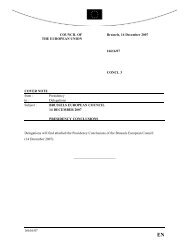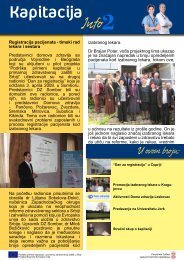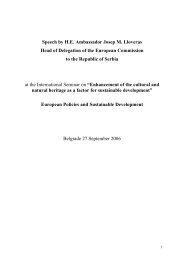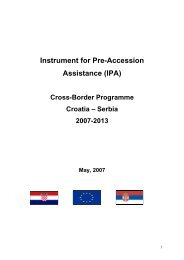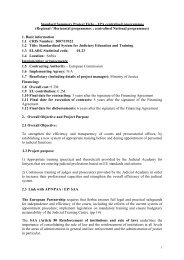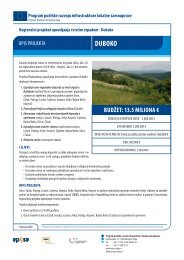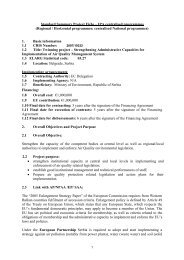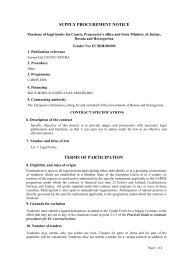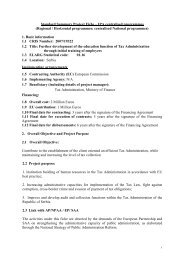Implementation of Common Aviation Area - European Commission
Implementation of Common Aviation Area - European Commission
Implementation of Common Aviation Area - European Commission
Create successful ePaper yourself
Turn your PDF publications into a flip-book with our unique Google optimized e-Paper software.
Standard Summary Project Fiche – IPA centralised programmes<br />
(Regional / Horizontal programmes ; centralised National programmes)<br />
1. Basic information<br />
1.1 CRIS Number: 2007/19322<br />
1.2 Title: <strong>Implementation</strong> <strong>of</strong> the <strong>European</strong> <strong>Common</strong> <strong>Aviation</strong> <strong>Area</strong><br />
1.3 ELARG Statistical code: 03.14<br />
1.4 Location: Serbia<br />
Implementing arrangements:<br />
1.5 Contracting Authority <strong>European</strong> <strong>Commission</strong><br />
1.6 Implementing Agency: N/A<br />
1.7 Beneficiary (including details <strong>of</strong> project manager): Civil <strong>Aviation</strong> Directorate <strong>of</strong> the<br />
Republic <strong>of</strong> Serbia (CAD)<br />
Financing:<br />
1.8 Overall cost: €2.0 Million<br />
1.9 EU contribution: €2.0 million<br />
1.10 Final date for contracting: 3 years after the signature <strong>of</strong> the Financing Agreement<br />
1.11 Final date for execution <strong>of</strong> contracts: 5 years after the signature <strong>of</strong> the Financing<br />
Agreement<br />
1.12 Final date for disbursements: 6 years after the signature <strong>of</strong> the Financing Agreement<br />
2. Overall Objective and Project Purpose<br />
2.1 Overall Objective:<br />
To support the Serbian <strong>Aviation</strong> authorities in meeting the demands <strong>of</strong> the <strong>European</strong> <strong>Common</strong><br />
<strong>Aviation</strong> <strong>Area</strong><br />
2.2 Project purpose:<br />
• Align Serbian transport/aviation legislation to EU standards supporting liberalisation <strong>of</strong><br />
market access, traffic rates and fares (including competition and state aid)<br />
• Support adoption by government <strong>of</strong> the air traffic management and the Single<br />
<strong>European</strong> Sky aspects <strong>of</strong> the acquis<br />
• Improve airport ground handling and slot allocation procedures/regulatory framework<br />
• Improve airport safety and security regulations/procedures<br />
• Improve and assist in the implementation <strong>of</strong> environmental standards and consumer<br />
rights in relation to the aviation industry<br />
2.3 Link with AP/NPAA / EP/ SAA<br />
In June 2006 the EU and the countries <strong>of</strong> South East Europe signed an agreement on the<br />
establishment <strong>of</strong> a <strong>European</strong> <strong>Common</strong> <strong>Aviation</strong> <strong>Area</strong> (ECAA) by 2010. The ECAA will<br />
amount to a full extension <strong>of</strong> the EU-internal air transport market to the Western Balkans. It<br />
entails the complete liberalization <strong>of</strong> cross-border traffic among signatories, an adoption <strong>of</strong><br />
the aviation-related acquis and comprehensive sector restructuring at the national level. This<br />
should trigger rapid traffic growth, encourage foreign investment in the sector and act as an<br />
1
important catalyst for broader regional integration. To reap those benefits the countries <strong>of</strong> the<br />
Western Balkans will have to implement an ambitious reform agenda in a relatively short<br />
time-span.<br />
The <strong>European</strong> Partnership document emphasizes the importance <strong>of</strong> continuation <strong>of</strong> alignment<br />
the aviation legislation with EU acquis.<br />
This project is in full compliance with the National Strategy <strong>of</strong> Serbia for EU Accession,<br />
where is stated that in order to approach and fulfil the <strong>European</strong> requirements:<br />
“Serbia needs to: a) gradually remove the remaining artificial barriers within every branch<br />
transport, b) implement the liberalisation simultaneously with passing the regulations that<br />
would conform to the EU standards in the area <strong>of</strong> pr<strong>of</strong>essional classification, safety, social<br />
measures and obligations relating to public services, d) pass compensation measures within<br />
the state aid to the public transport with a view to continue creating non-discriminatory<br />
conditions on the market, and f) conclude contracts on the access to the air transport service<br />
market and adjust to the rest <strong>of</strong> regulations <strong>of</strong> the EU’s common policy in this area. More<br />
specifically, Serbia needs to pass, amend and harmonise with the EU standards the following<br />
transport laws in the next year or two: comply with the Open Sky Agreement (ECAA<br />
Agreement) …”<br />
The draft document “Strategy and Policy <strong>of</strong> Transport Sector Development in Serbia until<br />
2015” recommends that priority should be given to the changes in the legal framework and<br />
full implementation <strong>of</strong> EU directives and other relevant international regulations, as well as<br />
the membership in international organizations, since they are necessary for the further<br />
development <strong>of</strong> this sector. The specific goals, important for the definition <strong>of</strong> strategies and<br />
action plans <strong>of</strong> the subjects in the air transport sector in Serbia are adoption <strong>of</strong> complementary<br />
law on air traffic and related regulations and norms, joining the JAA or EASA, establishing<br />
feeder and commuter services in air transport and establishing fast railway connection from<br />
the city centre to the Belgrade airport.<br />
Since one <strong>of</strong> the main objectives in the area <strong>of</strong> transport is full harmonization with EU<br />
requirements, the realization <strong>of</strong> the project will enable faster integration <strong>of</strong> the Republic <strong>of</strong><br />
Serbia into the EU in the area <strong>of</strong> civil aviation by means <strong>of</strong> creating a single aviation market,<br />
achieving high safety and security standards, improving regional cooperation and creating<br />
better investment opportunities for all interested parties.<br />
2.4 Link with MIPD<br />
In the Transport section <strong>of</strong> the MIPD support is to be directed to the Transport Authorities to<br />
meet demands <strong>of</strong> EU legislation; Implement the Memorandum <strong>of</strong> Understanding on the Core<br />
Regional Transport Network and to fully implement the <strong>European</strong> <strong>Common</strong> <strong>Aviation</strong> <strong>Area</strong><br />
Agreement. (Page 27)<br />
2.5 Link with National Development Plan (where applicable)<br />
N/A<br />
2.6 Link with national/ sectoral investment plans(where applicable)<br />
N/A<br />
2
3. Description <strong>of</strong> project<br />
3.1 Background and justification:<br />
On the basis <strong>of</strong> the National Strategy <strong>of</strong> the Republic <strong>of</strong> Serbia for EU Accession, Serbia<br />
signed the ECAA Agreement on 29 June 2006. By signing this Agreement, Serbia committed<br />
itself to the rapid implementation <strong>of</strong> EC aviation acquis for the purpose <strong>of</strong> ensuring high and<br />
uniformly applied safety and security standards, consumer rights rules, competition and state<br />
aid rules. The Agreement extents the Single <strong>European</strong> Sky to South-East <strong>European</strong> Region<br />
and facilitates the strengthening <strong>of</strong> economic and cultural links within Europe. This project is<br />
designed to provide assistance to achieve this overall objective.<br />
Civil <strong>Aviation</strong> Directorate <strong>of</strong> the Republic <strong>of</strong> Serbia (CAD), as a competent civil aviation<br />
authority in the Republic <strong>of</strong> Serbia, a successor to Civil <strong>Aviation</strong> Directorate <strong>of</strong> Serbia and<br />
Montenegro, founded in 2004. It performs its duties as a joint regulatory and oversight body<br />
on the basis <strong>of</strong> national and international regulations and by-laws, ratified international<br />
agreements, international standards and recommended practices with the crucial priority <strong>of</strong><br />
providing conditions for safe, secure and efficient air transport operations, observing market<br />
demands, principles <strong>of</strong> non-discrimination and transparency. It is worth noting that this kind<br />
<strong>of</strong> organization was approved and supported by all international auditors, since it enabled<br />
CAD to both retain and employ well educated and experienced staff.<br />
Since its establishment in 2004, CAD:<br />
- successfully completed the procedure for becoming the EUROCONTROL and JAA full<br />
member; concluded the negotiations for signing <strong>of</strong> the ECAA Agreement; undertook great<br />
efforts concerning the implementation <strong>of</strong> the ECAA Agreement; developed a Draft version <strong>of</strong><br />
Civil <strong>Aviation</strong> Law; provided advanced and recurrent trainings <strong>of</strong> the staff; actively<br />
participated in the work <strong>of</strong> all relevant international civil aviation organizations (ICAO,<br />
ECAC, EUROCONTROL, JAA).<br />
One <strong>of</strong> CAD’s main objectives in the future is full implementation <strong>of</strong> the ECAA Agreement<br />
with the view <strong>of</strong> enabling integration <strong>of</strong> the Serbian civil aviation into the Single <strong>European</strong><br />
Sky.<br />
Since implementation <strong>of</strong> the ECAA Agreement implies gradual transition to EU legal and<br />
operational practices, some <strong>of</strong> which were not previously applied in our country, and given<br />
the fact that civil aviation is a constantly changing area, adequate training <strong>of</strong> CAD’s staff and<br />
assistance <strong>of</strong> EU experts in development and implementation <strong>of</strong> new practices will<br />
significantly contribute to easier transition. This project should provide necessary assistance.<br />
Under CARDS the Republic <strong>of</strong> Serbia successfully cooperated with EU and benefited from its<br />
support to reform and modernization <strong>of</strong> the civil aviation sector. This assistance was mainly<br />
obtained through CARDS regional support in the area <strong>of</strong> air transport safety and air traffic<br />
management (ASATC Project), which is to be finalized by mid-2007.<br />
DG TREN organized two assessment visits to Serbia with the aims <strong>of</strong> monitoring the progress<br />
in the implementation <strong>of</strong> the aviation acquis (2005/6). On the basis <strong>of</strong> the Report on the<br />
ECAA Assessment (see Annex), conducted in October 2006 more technical assistance was<br />
recommended. The monitoring action also identified significant progress in preparations for<br />
accession to the ECAA was made in the safety area. The draft <strong>of</strong> a new aviation law<br />
3
developed in compliance with <strong>European</strong> regulations is in its last phase before ratification by<br />
the Serbian Parliament. However before adopting the law some adjustments have to be made.<br />
Basic aviation requirements: JAR 21, JAR-OPS 1 and 3, JAR-FCL 1 and 3, JAR 66, JAR<br />
145, JAR 147 have been implemented but not all are fully applied.<br />
While Serbia has full access to the Doc 30 Recommendations <strong>of</strong> ECAC, DG TREN has<br />
recommended that Serbia gets legal access to the EU Security <strong>Aviation</strong> Regulations as soon<br />
as possible.<br />
Serbia has already received substantial support under the CARDS projects Institutional<br />
Capacity Building Project in the Transport Sector, finalised in January 2007 and the ongoing<br />
Twinning project “First Alignment with the Transport Acquis”. The former has delivered<br />
Report nº 15, ‘’Institutional Development <strong>of</strong> the <strong>Aviation</strong> Sector’’ which informs this project<br />
fiche. The latter which began in September 2006 (lasting for 18 months) has, as one <strong>of</strong> the<br />
foreseen results, an EU harmonized Civil <strong>Aviation</strong> law.<br />
The overall objective <strong>of</strong> the project is to enable the integration <strong>of</strong> Serbian civil aviation into<br />
the EU aviation system by full implementation <strong>of</strong> the ECAA Agreement. The project will<br />
support the establishment <strong>of</strong> the regulatory and economic framework for civil aviation in<br />
Serbia. Furthermore it will support implementation <strong>of</strong> <strong>European</strong> regulations and requirements<br />
in the area <strong>of</strong> <strong>Aviation</strong> Safety, <strong>Aviation</strong> Security, Air Traffic Management, Airports, Noise<br />
and <strong>Aviation</strong> Environment Policy.<br />
3.2 Assessment <strong>of</strong> project impact, catalytic effect, sustainability and cross border impact<br />
(where applicable)<br />
Favourable geographical position <strong>of</strong> Serbia for transit transport <strong>of</strong>fers great potential for the<br />
development <strong>of</strong> intermodal transport. Rehabilitation work to date via CARDS and IFI funding<br />
on Eurocorridors X and VII and positive developments in the region further emphasise this<br />
potential.<br />
This project will support the creation <strong>of</strong> necessary legal framework, implementation <strong>of</strong><br />
recommendations and best EU practice, as well as implementation <strong>of</strong> technical and security<br />
regulations and establishment <strong>of</strong> conditions which shall contribute to air transport services<br />
improvement and overall economic development <strong>of</strong> Serbia.<br />
The implementation <strong>of</strong> this project will enhance development <strong>of</strong> intermodal transport<br />
terminals network in Serbia, networking between stakeholders enabling geographical<br />
grouping <strong>of</strong> independent companies and bodies which are dealing with freight transport (for<br />
example, freight forwarders, shippers, transport operators, customs).<br />
3.3 Results and measurable indicators:<br />
Results and measurable indicators in relation with Activity 1<br />
• Fulfilment <strong>of</strong> ECAA requirements in accordance with the pace provided in the<br />
Protocol <strong>of</strong> the Agreement;<br />
• Alignment with the EU acquis in the area <strong>of</strong> civil aviation;<br />
• Institutional and operational strengthening <strong>of</strong> the competent civil aviation authority;<br />
• Overall improvement <strong>of</strong> the aviation area in the Republic <strong>of</strong> Serbia;<br />
4
Results and measurable indicators in relation with Activity 2<br />
• Improved technical capacity to meet the ECAA requirements in aviation security<br />
3.4 Activities:<br />
Activity 1.<br />
Technical Assistance will address the following institutional building and training needs:<br />
1. Development <strong>of</strong> the concept <strong>of</strong> operating licence, issuing <strong>of</strong> operating licences and<br />
effective monitoring <strong>of</strong> their use;<br />
2. Assisting in the implementation <strong>of</strong> the National <strong>Aviation</strong> Security Quality Control<br />
Programme;<br />
3. Establishing security audit program;<br />
4. Assisting in the areas <strong>of</strong> Flight Data Processing System in the context <strong>of</strong> the new ATM<br />
system;<br />
5. Improving airport management;<br />
6. Assisting in finalising the new <strong>Aviation</strong> Law and subsequent development <strong>of</strong> by-laws in<br />
line with the EU acquis;<br />
7. Addressing Competition, State Aid in all issues <strong>of</strong> civil aviation;<br />
8. Development and implementation <strong>of</strong> Safety Management Systems in core areas.<br />
Training <strong>of</strong> <strong>Aviation</strong> Personnel<br />
1. <strong>Aviation</strong> Safety: EASA training on transition form JAA to EASA; Training on<br />
certification practices and safety oversight;<br />
2. <strong>Aviation</strong> Security: Training <strong>of</strong> national security inspectors on cargo security and security<br />
management; Training <strong>of</strong> x-ray operators;<br />
3. Air Traffic Management: Training <strong>of</strong> CAD staff in certification and audit process;<br />
Training and cooperation on Air Traffic Flow Management; Training <strong>of</strong> Air Traffic<br />
Controllers;<br />
4. Airport Management: Training <strong>of</strong> CAD inspectors on airport certification and licensing.<br />
Activity 2<br />
The following equipment units will be supplied under this fiche 1 :<br />
1. Heimann X-ray Tutor 2.0 Pr<strong>of</strong>essional or equivalent<br />
2. Standard Test Piece for Conventional X-ray for EDS and EDt<br />
3. Heimann X-ray with TIP or equivalent;<br />
4. HHMD with Test Piece or equivalent;<br />
5. Walk-through MD with Test Piece or equivalent;<br />
6. Millimetarvawe people screening system TADAR or equivalent.<br />
The activities will be delivered thorough service and supply contracts.<br />
1 Brand names only for illustrative purposes and should not be referenced on tendering documentation<br />
5
3.5 Conditionality and sequencing:<br />
- The activities under this project are conditional to continued commitment <strong>of</strong> the aviation civil<br />
aviation authorities to implementation <strong>of</strong> the ECAA Agreement<br />
- Government’s support, particularly from the Ministry <strong>of</strong> Infrastructure, must be obtained for<br />
the implementation <strong>of</strong> the ECAA Agreement<br />
- Civil <strong>Aviation</strong> Directorate, as the main beneficiary <strong>of</strong> the project, has to appoint appropriate<br />
counterpart personnel and define their competencies before the launch <strong>of</strong> the tender process<br />
- Furthermore, the Civil <strong>Aviation</strong> Directorate needs to ensure that it has enough qualified<br />
personnel able to operate sensitive and specialised equipment, which will be purchased as per<br />
Activity no. 2<br />
3.6 Linked activities<br />
The SEE FABA initiative was launched in 2005 with the objective <strong>of</strong> implementing the<br />
Single <strong>European</strong> Sky regulations in South East Europe under the umbrella <strong>of</strong> the <strong>European</strong><br />
<strong>Common</strong> <strong>Aviation</strong> <strong>Area</strong> (ECAA) agreement. The project, which aims to elaborate optimum<br />
Functional Airspace Blocks in the South East Europe, will last till 2009.<br />
Further support to the relevant aviation authorities <strong>of</strong> the Western Balkans is foreseen under<br />
IPA. Namely, Multi Beneficiary IPA will support networking between National Authorities as<br />
well as capacity building, the sharing <strong>of</strong> best practices and lessons learned (including<br />
provision for harmonising aviation security and safety standards).<br />
An ongoing Twinning project with the Ministry for Capital Investments (now Ministry <strong>of</strong><br />
Infrastructure) provides assistance in development <strong>of</strong> the new <strong>Aviation</strong> Law which should be<br />
in accordance with EU requirements.<br />
The demands <strong>of</strong> the acquis also incorporates regulations dealing with other than strictly<br />
aviation aspects (e.g. consumer protection, state aid, fair competition, processing <strong>of</strong> personal<br />
data, social aspects and environment) coordination and cooperation with relevant bodies and<br />
projects that are supporting these areas is necessary. Each <strong>of</strong> them should fulfil the<br />
responsibilities from the Agreement and find a way to facilitate coordination and<br />
communication with other institutions involved in the process.<br />
3.7 Lessons learned<br />
The growth <strong>of</strong> transport will continue to cause congestion <strong>of</strong> trucks and trailers on roads<br />
resulting in high rates <strong>of</strong> accidents, high levels <strong>of</strong> pollution and noise, it will also reduce<br />
mobility <strong>of</strong> goods and people and decrease use <strong>of</strong> infrastructure. The EU gives high priority to<br />
intermodal transport which provides possibilities for transport <strong>of</strong> goods by different modes <strong>of</strong><br />
transport. The aim <strong>of</strong> its policy is to support efficient movement <strong>of</strong> goods, using two or more<br />
modes <strong>of</strong> transport, in an integrated transport chain. Each mode <strong>of</strong> transport has its own<br />
advantages (potential capacity, high levels <strong>of</strong> safety, flexibility, low energy consumption, low<br />
environmental impact) and intermodal transport allows each mode to play its role in building<br />
transport chains which overall are more efficient, cost effective and sustainable.<br />
Although there is a consensus to introduce and develop intermodal transport in Serbia, the<br />
existing level <strong>of</strong> it is still very low. Traffic flows are limited, and, generally, present facilities<br />
6
and equipment are not fully utilised. It is important for Serbia, in order to subsist and increase<br />
its participation in world market exchange, to accept contemporary methods and transport<br />
technologies, to adjust its infrastructure and equipment to modern transport technologies, as<br />
an important factor for maintaining competitiveness <strong>of</strong> its goods and its transport services.<br />
The goal is to <strong>of</strong>fer high quality <strong>of</strong> logistic services.<br />
4. Indicative Budget (amounts in million €)<br />
SOURCES OF FUNDING<br />
TOTAL<br />
COST EU CONTRIBUTION NATIONAL PUBLIC CONTRIBUTION PRIVATE<br />
Activities Total % * IB INV Total % * Central Regional IFIs Total % *<br />
Activity 1<br />
contract 1.1 1.7 1.7 1.7<br />
contract 1.2<br />
Activity 2<br />
contract 2.1 0.3 0.3 0.3<br />
contract 2.2<br />
……<br />
TOTAL 2<br />
* expressed in % <strong>of</strong> the Total Cost<br />
5. Indicative <strong>Implementation</strong> Schedule (periods broken down per quarter) 2<br />
Contracts Start <strong>of</strong> Signature <strong>of</strong> Project<br />
Tendering contract Completion<br />
Contract 1.1 T+1Q T+2Q T+8Q<br />
Contract 1.2 T+1Q T+3Q T+8Q<br />
All projects should in principle be ready for tendering in the 1 ST Quarter following the<br />
signature <strong>of</strong> the FA<br />
6. Cross cutting issues (where applicable)<br />
Development Policy Joint Statement by the Council and the <strong>European</strong> <strong>Commission</strong> <strong>of</strong> 10<br />
November 2000 establishes that a number <strong>of</strong> Cross-cutting Issues shall be mainstreamed into<br />
EC development co-operation and assistance.<br />
Cross-cutting issues will be addressed in the project so as to comply with the best EU<br />
standards and practice in that area and in a way which demonstrates how they will be dealt<br />
with within the project’s framework, its activities and outputs.<br />
2 where T=the date <strong>of</strong> the signature <strong>of</strong> the FA and xQ equals the number (x) <strong>of</strong> quarters (Q) following T<br />
7
Cross-cutting issues will be addressed in a proactive manner, and will present a specific<br />
component <strong>of</strong> projects (at all levels <strong>of</strong> projects' development, starting from the project<br />
identification stage). Synergies between the projects and the objectives <strong>of</strong> will be identified<br />
and developed. Also, the projects’ objectives and activities need to be screened in order to<br />
ensure they won’t impact negatively on gender equality, minorities’ inclusion and<br />
environment.<br />
Finally, the beneficiary will make sure its objectives, policies and interventions have a<br />
positive impact on and are in line with the main principles <strong>of</strong> gender equality, minorities’<br />
inclusion and environment.<br />
6.1 Equal Opportunity<br />
The service provider for this project will ensure that their human resource policies and<br />
procedures take account <strong>of</strong> gender differences. Criteria should be introduced to ensure that<br />
gender equality measures are pursued.<br />
6.2 Environment<br />
The <strong>European</strong> <strong>Common</strong> <strong>Aviation</strong> <strong>Area</strong> (ECAA) agreement and its implementation covers<br />
current and future EU legislation on emissions, noise and other measures that will reduce the<br />
environmental impact <strong>of</strong> aviation.<br />
6.3 Minorities<br />
Transport is one <strong>of</strong> the priority areas which do not primarily impact minority issues. At the<br />
same time, they might have long-term repercussions on minorities. Thus, project needs to<br />
consider whether minorities are also beneficiaries <strong>of</strong> some <strong>of</strong> the measures, or whether, due to<br />
geographical disbursement (or other regions), only majority communities benefit from these<br />
measures. 3<br />
3 Taken from “EAR Practical Guide on Minority Issues Mainstreaming”<br />
8
ANNEX I: Logical framework matrix in standard format<br />
LOGFRAME PLANNING MATRIX FOR Project Fiche Programme name and number<br />
<strong>Implementation</strong> <strong>of</strong> the <strong>European</strong> <strong>Common</strong> <strong>Aviation</strong> <strong>Area</strong><br />
9<br />
Contracting period expires 5 years after the signature <strong>of</strong> the<br />
Financing Agreement<br />
Total budget :<br />
€ 2.00 Million<br />
Overall objective Objectively verifiable indicators Sources <strong>of</strong> Verification<br />
To support the Serbian <strong>Aviation</strong> Authorities in<br />
meeting the demands <strong>of</strong> the <strong>European</strong> <strong>Common</strong><br />
<strong>Aviation</strong> <strong>Area</strong><br />
Project purpose<br />
Align Serbian transport/aviation legislation to EU<br />
standards supporting liberalisation <strong>of</strong> market<br />
access, traffic rates and fares (including<br />
competition and state aid)<br />
Support adoption by government <strong>of</strong> the air traffic<br />
management and the Single <strong>European</strong> Sky aspects<br />
<strong>of</strong> the Acquis<br />
Improve airport ground handling and slot allocation<br />
procedures/regulatory framework<br />
Improve airport safety and security<br />
regulations/procedures<br />
<strong>Implementation</strong> <strong>of</strong> the ECAA Agreement Ministry <strong>of</strong> Infrastructure and EU reports on the implementation <strong>of</strong> the<br />
ECAA Agreement<br />
Objectively verifiable indicators<br />
<strong>Implementation</strong>s <strong>of</strong> the requirements in:<br />
Operating license and monitoring<br />
National <strong>Aviation</strong> Security Quality Control Programme<br />
Security Audit Programme<br />
ATM system<br />
Airport management development<br />
Civil <strong>Aviation</strong> and By-laws.<br />
Clear regulations on State Aid and Competition in all issues <strong>of</strong><br />
Civil <strong>Aviation</strong><br />
Safety management Systems<br />
Disbursement period expires 6 years after the<br />
signature <strong>of</strong> the Financing Agreement<br />
IPA budget:<br />
€ 2.00 Million<br />
Sources <strong>of</strong> Verification Assumptions<br />
Ministry <strong>of</strong> Infrastructure and EU-Serbia Enhanced Permanent Dialogue<br />
Reports.<br />
Improve and assist in the implementation <strong>of</strong><br />
environmental standards and consumer rights in<br />
relation to the aviation industry<br />
Results Objectively verifiable indicators Sources <strong>of</strong> Verification Assumptions<br />
ECAA requirements fulfilled in accordance with the<br />
pace provided for in the Protocol <strong>of</strong> the Agreement;<br />
EU acquis aligned in the area <strong>of</strong> civil aviation<br />
Strong and fully operational competent civil aviation<br />
authority;<br />
Technical assistance performed covering all the areas<br />
concerning the implementation <strong>of</strong> the ECAA.<br />
Training on:<br />
<strong>Aviation</strong> Safety<br />
<strong>Aviation</strong> Security<br />
Air Traffic Management<br />
Airport Management.<br />
Continued commitment <strong>of</strong> the Serbian Authorities towards the<br />
implementation <strong>of</strong> the ECAA Agreement.<br />
Political stability on order have the parliamentary approval <strong>of</strong><br />
the various laws and regulations towards the approximation <strong>of</strong><br />
the acquis<br />
Ministry <strong>of</strong> Infrastructure- Civil <strong>Aviation</strong> Directorate Full commitment <strong>of</strong> the relevant Serbian Authorities, towards<br />
the implementation <strong>of</strong> the ECCA Agreement.<br />
Improved environmental performance <strong>of</strong> the civil<br />
aviation sector in the Republic <strong>of</strong> Serbia<br />
Supplies on:<br />
Safety, Security, air management and airport Equipment.<br />
Activities Means Costs Assumptions<br />
Technical assistance on specific related areas<br />
Training activities related to the results<br />
Service and supplies contracts 2 Million Euros (100% IPA Contribution) Full commitment <strong>of</strong> the relevant Serbian Authorities towards<br />
the implementation <strong>of</strong> the ECCA Agreement<br />
Supply <strong>of</strong> various equipment needed to the better<br />
implementation <strong>of</strong> the agreement
10<br />
ANNEX II: amounts (in M€) Contracted and disbursed by quarter for the project<br />
Contracted<br />
Contract<br />
Q1 Q2 Q3 Q4 Q5 Q6 Q7 Q8 Q9 Q10 Q11<br />
1.1<br />
1.7<br />
Contract<br />
1.2<br />
Contract<br />
1.3<br />
Contract<br />
1.4<br />
……<br />
0.3<br />
Cumulated 1.7 2.0<br />
Disbursed<br />
Contract<br />
1.1<br />
Contract<br />
1.2<br />
Contract<br />
1.3<br />
Contract<br />
1.4<br />
……<br />
1,020,000 102,000 102,000 102,000 102,000 102,000 170,000<br />
180,000 90,000 30,000<br />
Cumulated 1,020,000 1,302,000 1,404,000 1,596,000 1,698,000 1,800,000 2,000,000
ANNEX III<br />
Description <strong>of</strong> Institutional Framework<br />
The institution in charge <strong>of</strong> implementation and monitoring <strong>of</strong> implementation <strong>of</strong> this project is<br />
the Civil <strong>Aviation</strong> Directorate (CAD). It was established as a joint regulatory and supervisory<br />
body for civil aviation on 1 January 2004. Decision on the Establishment <strong>of</strong> the Civil <strong>Aviation</strong><br />
Directorate <strong>of</strong> the State <strong>of</strong> Serbia and the State <strong>of</strong> Montenegro was published in the “Official<br />
Gazette <strong>of</strong> RS”, No. 102/2003 and “Official Gazette <strong>of</strong> RM”, No. 61/2003.<br />
11<br />
Organigramme <strong>of</strong> CAD 4<br />
ANNEX IV<br />
Reference to laws, regulations and strategic documents:<br />
Reference list <strong>of</strong> relevant laws and regulations<br />
- Strategy and Policy <strong>of</strong> Transport Sector Development in Serbia until 2015<br />
- Regulations on the identity card <strong>of</strong> the aviation inspector <strong>of</strong> the Civil <strong>Aviation</strong> Directorate <strong>of</strong><br />
the State <strong>of</strong> Serbia and the State <strong>of</strong> Montenegro ;<br />
“Official Gazette RS”, No.51/2004 “Official Gazette RM”, No.30/2004<br />
4 Taken from www.cad.gov.yu
- Order on the designation <strong>of</strong> border corridors;<br />
“Official Gazette RS”, No.29/2004 “Official Gazette RM”, No. 3/2004<br />
- Order on the designation <strong>of</strong> the airways and routes;<br />
“Official Gazette RS”, No.29/2004 “Official Gazette RM”, No. 3/2004<br />
- Order on the working hours <strong>of</strong> the airports when they have to be opened to public air<br />
transport (in Summer Season from 28.03. until 30.10.2004);<br />
“Official Gazette RS”, No.32/2004 “Official Gazette RM”, No.18/2004<br />
- Order on the level <strong>of</strong> charges for the test <strong>of</strong> skill <strong>of</strong> authorized aviation personnel;<br />
“Official Gazette RS”, No.29/2004 “Official Gazette RM”, No18/2004<br />
- Order on the level <strong>of</strong> charges for the issue <strong>of</strong> an approval for a location and design<br />
documentation related to the construction or reconstruction <strong>of</strong> an airport and other facilities<br />
from the standpoint <strong>of</strong> air traffic safety;<br />
“Official Gazette RS”, No.52/2004 “Official Gazette RM”, No.31/2004<br />
- Order on the level <strong>of</strong> charges for the airports and facilities inspection upon the completion <strong>of</strong><br />
construction, reconstruction, change <strong>of</strong> purpose or category and prolonged closure;<br />
“Official Gazette RS”, No.52/2004 “Official Gazette RM”, No. 31/2004<br />
- Order on the level <strong>of</strong> charges for the inspection <strong>of</strong> an airfield upon the completion <strong>of</strong> the<br />
construction and review <strong>of</strong> the terrain, after putting everything in order;<br />
“Official Gazette RS”, No. 52/2004 “Official Gazette RM”, No.31/2004<br />
- Order on the level <strong>of</strong> charges for the designation and check whether an airport meets the<br />
requirements for providing information to the aircraft in flight within the airport traffic area,<br />
meteorological observations and provision <strong>of</strong> technical devices at the airport are performed by<br />
the airport owner or operator;<br />
“Official Gazette RS”, No.52/2004 “Official Gazette RM”, No.31/2004<br />
- Order on the level <strong>of</strong> charges for the issue <strong>of</strong> a Certificate <strong>of</strong> competence for the purpose <strong>of</strong><br />
aviation personnel training;<br />
“Official Gazette RS”, No.61/2004 “Official Gazette RM”, No.35/2004<br />
- Order on the level <strong>of</strong> charges for designation and check <strong>of</strong> condition for operation <strong>of</strong> medical<br />
transport and rendering <strong>of</strong> services from the air;<br />
“Official Gazette RS”, No.61/2004 “Official Gazette RM”, No.35/2004<br />
- Order on the level <strong>of</strong> charges for aircraft inspection, for the purpose <strong>of</strong> airworthiness;<br />
“Official Gazette RS”, No.53/2004 “Official Gazette RM”, No.31/2004<br />
- Order on the level <strong>of</strong> charges for checking conditions for enterprise activities, other legal<br />
person, State agency or entrepreneur who manufacture, test for the purpose <strong>of</strong> type<br />
designation, or maintain the engine, propeller and aviation product or its components;<br />
“Official Gazette RS”,No.53/2004 “Official Gazette RM”,No.31/2004<br />
- Order on the level <strong>of</strong> charges for the inspection <strong>of</strong> flight simulators and the approval <strong>of</strong><br />
technical maintenance programme;<br />
12
“Official Gazette RS”, No.53/2004 “Official Gazette RS”, No. 31/2004<br />
- Order on the level <strong>of</strong> charges for medical examination by the second instance Medical<br />
<strong>Commission</strong>;<br />
“Official Gazette RS”, No.58/2004 “Official Gazette RM”,No.34/2004<br />
- Order on the level <strong>of</strong> charges for checking whether an approved medical institution continues<br />
to meet the requirements for performing medical examinations <strong>of</strong> authorized aviation<br />
personnel;<br />
“Official Gazette RS”, No.58/2004 “Official Gazette RM”, No.34 /2004<br />
- Order on the level <strong>of</strong> charges for establishment and check <strong>of</strong> the conditions for operation <strong>of</strong><br />
public air transport;<br />
“Official Gazette RS”, No.66/2004 “Official Gazette RM”, No.40/2004<br />
Reference to AP /NPAA / EP / SAA<br />
In June 2006 the EU and the countries <strong>of</strong> South East Europe signed an agreement on the<br />
establishment <strong>of</strong> a <strong>European</strong> <strong>Common</strong> <strong>Aviation</strong> <strong>Area</strong> (ECAA) by 2010. The ECAA will<br />
amount to a full extension <strong>of</strong> the EU-internal air transport market to the Western Balkans. It<br />
entails the complete liberalization <strong>of</strong> cross-border traffic among signatories, an adoption <strong>of</strong><br />
the aviation-related acquis and comprehensive sector restructuring at the national level. This<br />
should trigger rapid traffic growth, encourage foreign investment in the sector and act as an<br />
important catalyst for broader regional integration. To reap those benefits the countries <strong>of</strong> the<br />
Western Balkans will have to implement an ambitious reform agenda in a relatively short<br />
time-span.<br />
The <strong>European</strong> Partnership document emphasizes the importance <strong>of</strong> continuation <strong>of</strong> alignment<br />
the aviation legislation with EU acquis.<br />
This project is in full compliance with the National Strategy <strong>of</strong> Serbia for EU Accession,<br />
where is stated that in order to approach and fulfil the <strong>European</strong> requirements:<br />
“Serbia needs to: a) gradually remove the remaining artificial barriers within every branch<br />
transport, b) implement the liberalisation simultaneously with passing the regulations that<br />
would conform to the EU standards in the area <strong>of</strong> pr<strong>of</strong>essional classification, safety, social<br />
measures and obligations relating to public services, d) pass compensation measures within<br />
the state aid to the public transport with a view to continue creating non-discriminatory<br />
conditions on the market, and f) conclude contracts on the access to the air transport service<br />
market and adjust to the rest <strong>of</strong> regulations <strong>of</strong> the EU’s common policy in this area. More<br />
specifically, Serbia needs to pass, amend and harmonise with the EU standards the following<br />
transport laws in the next year or two: comply with the Open Sky Agreement (ECAA<br />
Agreement) …”<br />
The draft document “Strategy and Policy <strong>of</strong> Transport Sector Development in Serbia until<br />
2015” recommends that priority should be given to the changes in the legal framework and<br />
full implementation <strong>of</strong> EU directives and other relevant international regulations, as well as<br />
the membership in international organizations, since they are necessary for the further<br />
development <strong>of</strong> this sector. The specific goals, important for the definition <strong>of</strong> strategies and<br />
13
action plans <strong>of</strong> the subjects in the air transport sector in Serbia are adoption <strong>of</strong> complementary<br />
law on air traffic and related regulations and norms, joining the JAA or EASA, establishing<br />
feeder and commuter services in air transport and establishing fast railway connection from<br />
the city centre to the Belgrade airport.<br />
Since one <strong>of</strong> the main objectives in the area <strong>of</strong> transport is full harmonization with EU<br />
requirements, the realization <strong>of</strong> the project will enable faster integration <strong>of</strong> the Republic <strong>of</strong><br />
Serbia into the EU in the area <strong>of</strong> civil aviation by means <strong>of</strong> creating a single aviation market,<br />
achieving high safety and security standards, improving regional cooperation and creating<br />
better investment opportunities for all interested parties.<br />
Reference to MIPD<br />
In the Transport section <strong>of</strong> the MIPD support is to be directed to the Transport Authorities to<br />
meet demands <strong>of</strong> EU legislation; Implement the Memorandum <strong>of</strong> Understanding on the Core<br />
Regional Transport Network and to fully implement the <strong>European</strong> <strong>Common</strong> <strong>Aviation</strong> <strong>Area</strong><br />
Agreement. (Page 27)<br />
Reference to National Development Plan<br />
N/A<br />
Reference to national / sectoral investment plans<br />
N/A<br />
ANNEX V<br />
Details per EU funded contract (*) where applicable:<br />
Activity 1.<br />
14<br />
Technical Assistance will address the following institutional building and training needs:<br />
1. Development <strong>of</strong> the concept <strong>of</strong> operating licence, issuing <strong>of</strong> operating licences and<br />
effective monitoring <strong>of</strong> their use;<br />
9. Assisting in the implementation <strong>of</strong> the National <strong>Aviation</strong> Security Quality Control<br />
Programme;<br />
10. Establishing security audit program;<br />
11. Assisting in the areas <strong>of</strong> Flight Data Processing System in the context <strong>of</strong> the new ATM<br />
system;<br />
12. Improving airport management;<br />
13. Assisting in finalising the new <strong>Aviation</strong> Law and subsequent development <strong>of</strong> by-laws in<br />
line with the EU acquis;<br />
14. Addressing Competition, State Aid in all issues <strong>of</strong> civil aviation;<br />
15. Development and implementation <strong>of</strong> Safety Management Systems in core areas.<br />
Training <strong>of</strong> <strong>Aviation</strong> Personnel<br />
5. <strong>Aviation</strong> Safety: EASA training on transition form JAA to EASA; Training on<br />
certification practices and safety oversight;<br />
6. <strong>Aviation</strong> Security: Training <strong>of</strong> national security inspectors on cargo security and security<br />
management; Training <strong>of</strong> x-ray operators;
7. Air Traffic Management: Training <strong>of</strong> CAD staff in certification and audit process;<br />
Training and cooperation on Air Traffic Flow Management; Training <strong>of</strong> Air Traffic<br />
Controllers;<br />
8. Airport Management: Training <strong>of</strong> CAD inspectors on airport certification and licensing.<br />
Activity 2<br />
The following equipment units will be supplied under this fiche 5 :<br />
1. Heimann X-ray Tutor 2.0 Pr<strong>of</strong>essional or equivalent<br />
2. Standard Test Piece for Conventional X-ray for EDS and EDt<br />
3. Heimann X-ray with TIP or equivalent;<br />
4. HHMD with Test Piece or equivalent;<br />
5. Walk-through MD with Test Piece or equivalent;<br />
6. Millimetarvawe people screening system TADAR or equivalent.<br />
5 Brand names only for illustrative purposes and should not be referenced on tendering documentation<br />
15



